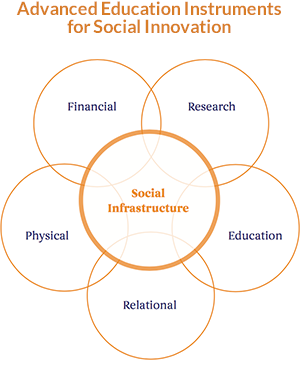Coro’s Blog: On Purpose
Universities: Show us what you’ve got!
Published on June 26, 2017

We live in a volatile, uncertain and complex world. With threats of climate change, rising income inequality, social unrest, resource scarcity and ecological degradation predicted to affect society’s progress, leaders and the institutions they run must play new roles to realize a sustainable future.
Breakthrough innovation is essential, requiring paradigm shifts and pivots in how we operate and function as a society.
Advanced education institutions – universities, colleges and polytechnic institutes – are ideally positioned to accelerate and scale the transition to a just and sustainable world. They already significantly contribute through their traditional teaching and research functions. Now we need them to intensify their efforts to tackle global challenges by going beyond teaching and research. Institutions must embed their social mandates into everything they do including within their administrative roles, capital projects, physical assets, and relationships.
Fortunately, community engagement is a burgeoning area of practice within advanced education. Myriad departments, centres and projects are involved in this nascent field of practice, with individual professors and institutes working with community partners on critical issues.
Problem:
Despite a plethora of activities and pockets of great practice, a strong and strategic institutional commitment is often lacking. There is an absence of a narrative or framework that recognizes their importance, and that motivates, accelerates and scales social innovation – and celebrates its social impact.
Solution:
Mobilizing institutions to contribute more holistically and consistently to social innovation and the communities they support starts by taking a community lens to an institution’s assets. These assets, or instruments, can be multi-purposed to achieve greater community impacts than their conventional counterparts. Investment for financial impact? Great. Investment for social and financial impact? Better. Procurement that achieves price, quality and convenience goals? Necessary. Social procurement? Better. And on, and on.
This is already happening.
 SFU and McConnell Foundation commissioned me to write this report on “Maximizing the Capacities of Advanced Education Institutions to Build Social Infrastructure for Canadian Communities” to understand the state of play in which institutions harness non-traditional assets (including but beyond teaching and research) to contribute to social well-being. As shown in this diagram, institutions are starting to embed their social objectives into their financial, physical and relational roles alongside their traditional research and education objectives.
SFU and McConnell Foundation commissioned me to write this report on “Maximizing the Capacities of Advanced Education Institutions to Build Social Infrastructure for Canadian Communities” to understand the state of play in which institutions harness non-traditional assets (including but beyond teaching and research) to contribute to social well-being. As shown in this diagram, institutions are starting to embed their social objectives into their financial, physical and relational roles alongside their traditional research and education objectives.
This paper identifies no less than thirty such opportunities available to institutions. There are likely more. Check out this one-pager for the preliminary list.
To use the examples above, note these investment, procurement and hiring initiatives within BC institutions:
- Social Investment: Simon Fraser University set goals to reduce the carbon footprint of its investment portfolios by 30 percent by 2030 – in line with Canada’s national climate commitment. UBC’s investments include $265 million in social housing and another $117 million in greenhouse gas emission reduction projects.
- Social Hiring: University of Victoria has an Employment Equity Plan with a goal to improve the participation of members of designated groups such as Indigenous Peoples, Visible Minorities and Persons with Disabilities in all jobs and at all levels where they are under-represented.
- Social Procurement: The grounds and gardens at Vancouver Community College are maintained by Mission Possible, a maintenance company that employs inner-city residents and assists those with employment barriers to reach their full potential.
Academic institutions are also developing solutions-generating social infrastructure such as social innovation labs like Radius and thought leadership platforms like Clean Energy Canada. These innovation hubs are mobilizing talent, resources and relationships to ideate, test and scale essential societal solutions.
Notably, the private sector has much to offer the post-secondary sector on its social innovation journey. This guide for companies on social hiring, social procurement, living wages and social innovation can be easily tailored to advanced ed. Equally, companies seeking to embed their social purpose throughout their operations will be fast on the heels of educational institutions, learning and scaling their successes within their for-profit business models.
The public and private sectors have much to learn from each other. All post-secondary institutions are inherent drivers of social progress: the time is now ripe for a community pivot. The complexities of this era call for advanced education institutions to reconceive conventional assets and instruments to serve an even higher purpose.
We have no time to lose. Universities: show us what you’ve got!
For more insights on maximizing the capacity of advanced education to build social infrastructure, read this paper.
Browse By Category
Browse blog posts by category below, or return to the main blog page to search or browse by keyword.
Subscribe to Coro’s Newsletter
A few times a year, Strandberg Consulting sends out a newsletter to keep Coro’s network up-to-date on her latest projects, publications and tools. You may subscribe to the newsletter here or visit the archives.



